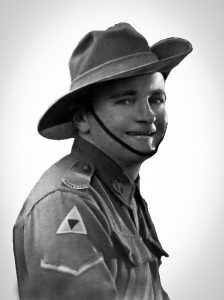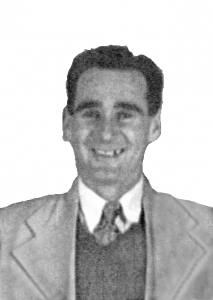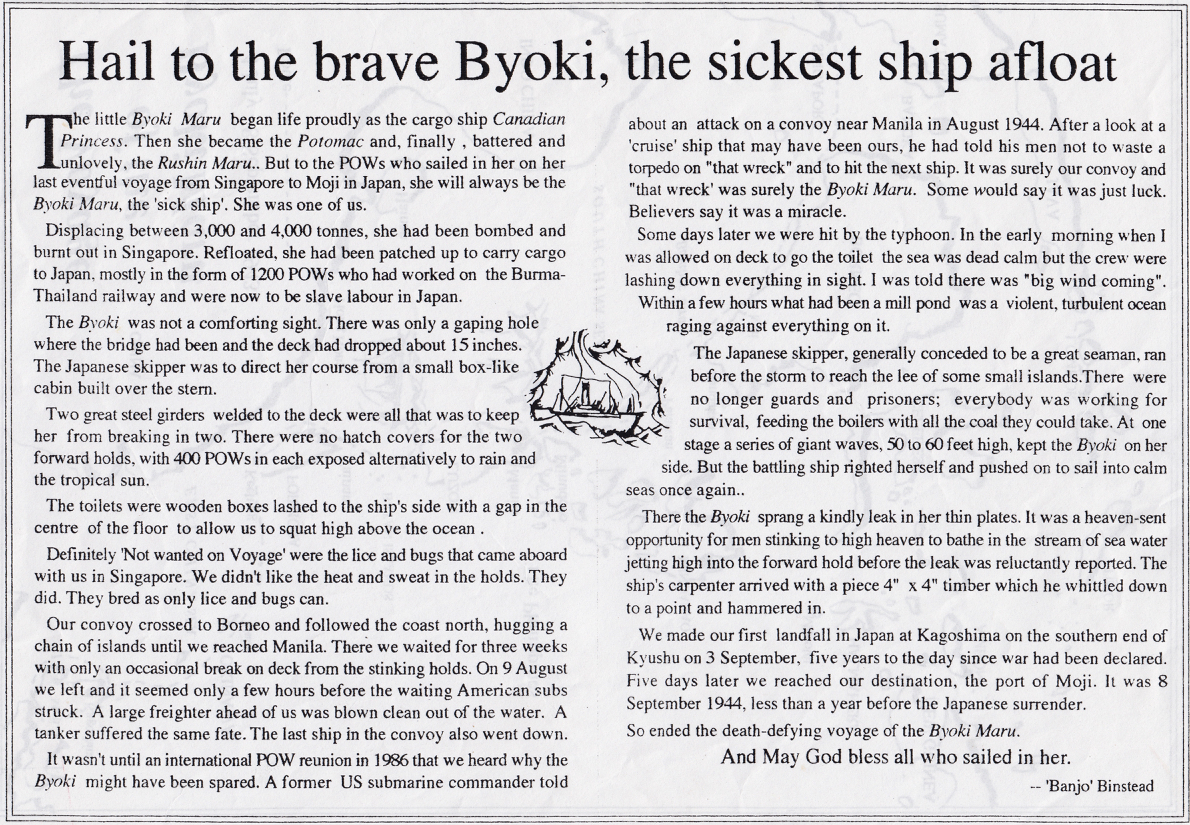Rashin (Byoki) Maru
The Junk Ship which took 70 days sailing Singapore to Japan – surviving Allied submarine attacks and a typhoon
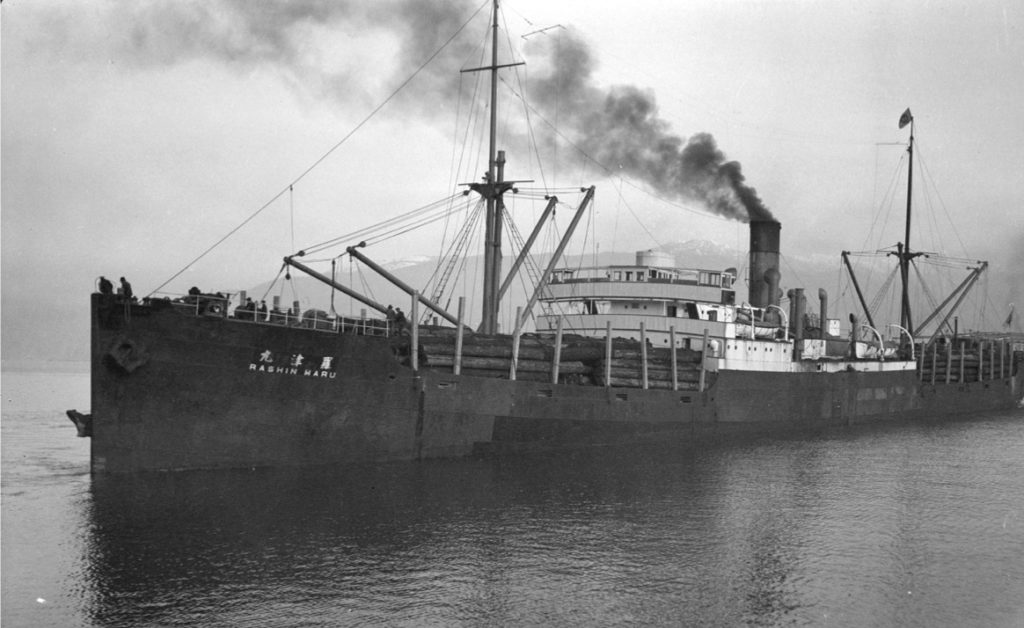
Having survived the horrors of labouring on the Burma Thai railway, since January 1943, those members of D Force that were deemed fit enough were drafted into Japan Party. Again to advance the Japanese war machine, this time as labourers in Nippon. Amongst them were seven members of the 2/4th machine gun battalion including Doug Carter WX8240, Alex Oag WX8481, Bert Poulton WX9764, Aub Schuts WX8562, Arthur Walker WX16370, Alf Worth WX7440 and Bob Whitelaw WX9076.
In fact there were many more machine gunners with ‘D’ Force Thailand who sailed with Rashin Maru to Japan.
The journey from Tamuang, Thailand 21st June 1944 to Singapore, 26th June was slow. In the iron trucks they broiled by day and shivered by night, crowded thirty to a truck. Only half of them could stretch out at a time.
For the next week the men were part of working parties around River Valley Camp, Changi. One day some of the men came back with a tall story of a ship being loaded with bales of rubber. ‘Her forward holds had been burnt out. The decks were littered with wreckage. She couldn’t last a day at sea’, they said. They joked about it being the ship they would travel to Japan on.
The first Japan Party had already left from Saigon. But the Allied submarine offensive forced the Japanese to send this and subsequent convoys from Singapore to sneak across to Borneo along the coasts of the island chains.
On the 1st July they marched to the harbour from Changi. There lay the ship that was to take them from Japan. ‘It’s the bloody ship we were kidding about.’ There was no bridge to speak of, it had been bombed and burnt out, a transitory wooden hut had been built aft on the poop. This was to be the men’s home for the next 70 days.
‘I wonder what her name is?’
She’ll be something Maru now you can bet.’
‘There’s only one name they can give her…’
‘What?’
‘The BYOKI Maru!’ Byoki being the Japanese word for ‘sick’
Below: Sailing Route of Byoki Maru – from Beattie Collection from a Rashin Maru POW Reunion.

There were 1250 men (1000 Australians) to go on board. The ship had already been loaded with tin and rubber.
They were herded up the gangway with shouts and pushes. On the way they had to go through a low cargo shed where each man had to pick up two bales of sheet rubber weighing around 75lbs. The guards told them that they could be used as lifebelts, the bales floated but only just. Struggling aboard the men deposited them using the bales as a seat with the bulkhead as a backrest. With hard feet and knees in their backs and elbows in their ribs they sat around an open hold twenty feet below them with nothing but a four-inch coaming to stop them falling over the edge. Six hundred men had been squeezed into the forward open hatches. Serving out the meagre meal of rice for them was all confusion and complaint, they were afraid of being missed out. It was almost impossible to put a foot between the men.
Initially only men going to the latrine were allowed on deck. There were only four latrines (for 1250 men), wooden structures built out over the side.
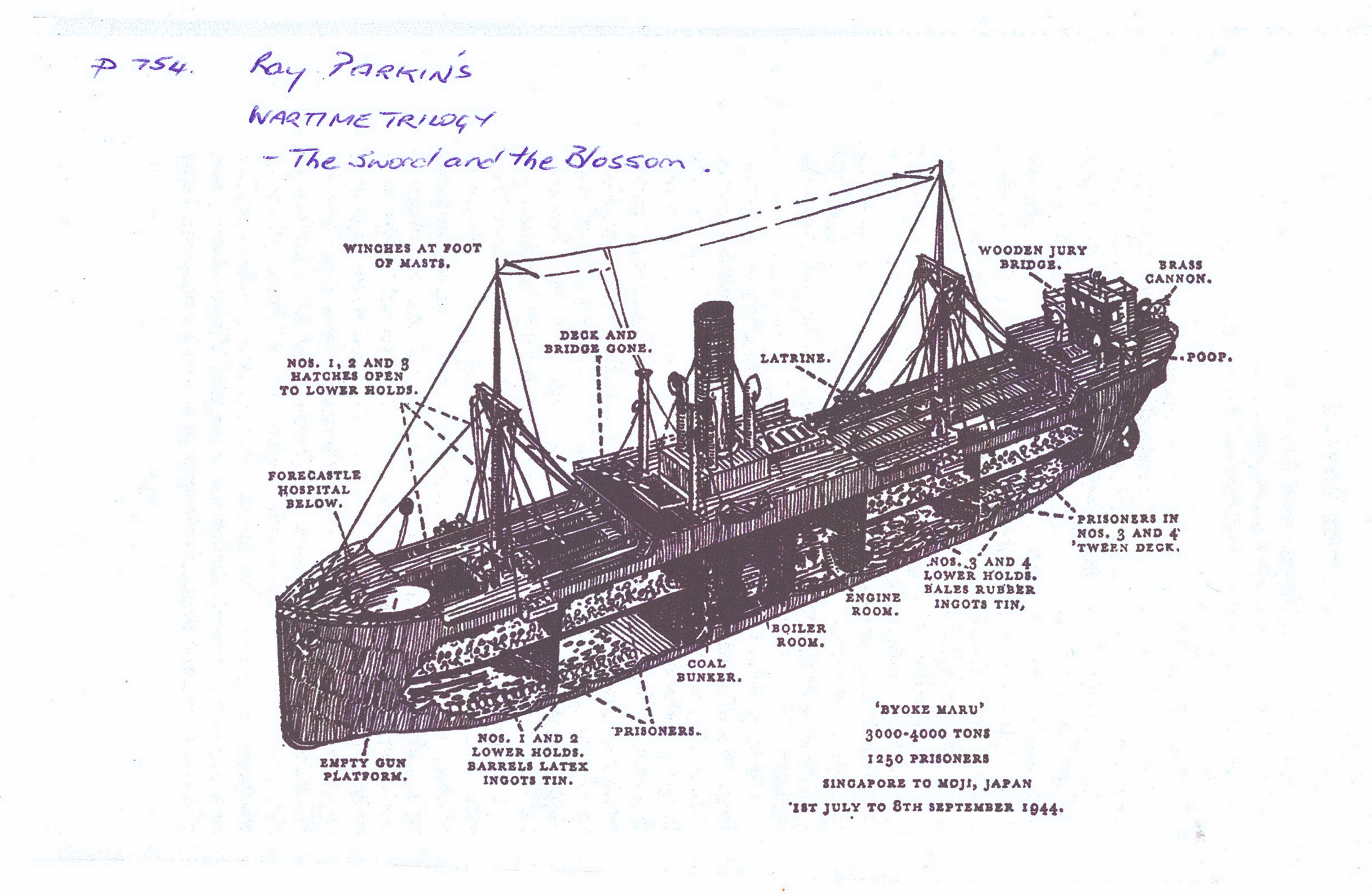
The transport took place in a convoy of 10 ships (among 4 other ships with POW’s: Asaka Maru 1, Hakushika Maru, Hofuku Maru and Sekiho Maru).
With the convoy being persistently challenged by submarines of the allied forces, they zig zagged passed Borneo and the Phillipines taking shelter in quieter waters after other ships in the convoy had been sunk.
On 8-7-1944 the convoy arrived in Miri (halfway up the north-coast of Borneo); here the composition of the convoy was changed (the Hofuku Maru remained in Miri).
On 26-7-1944 the ship arrived in Manila; here the ship must wait for a new convoy: on 9-8-1944 (after a stay of 15 days**) the ship sailed together with the Asaka Maru 1 for Formosa (via Takao in the south to Keelung in the north, navigating close to the coast). **some versions say 3 weeks in total.
After leaving Manila the ship immediately in front and the ship behind were torpedoed.
With minimal space, disease such as malaria and dysentery, the fetid atmosphere became a breeding ground for bugs. To relieve this the men managed to surreptitiously dispose of as many of the bales of rubber over the side at night time, one breeding source of bugs removed. The guards would never come into the hold and therefore were none the wiser. Then the Japanese decided to get rid of the flies, each man had to catch 10 flies a day. These were counted by the ‘Tiger’ and an officer with slapping and much unpleasantness for a short tally.
On August 13th an even more insidious threat, a typhoon. It was as if only the age-old sea knew how to defeat these men after the jungle, disease and the Japanese had failed. That night the wind became gusty, howling over the ship and then dropping away. Heavy rain-squalls swept over them. Those on that section of hatches in the square were half-drowned. They tried to crowd into another shelter under the coamings. It was impossible, they were beyond complaining. The ship flung them, sweat streaming and rain streaming, against each other. It was too dangerous for the men to go on deck now. The seasick added their groans and substance to the thick pungency.
The ship seemed as if she were driving straight at the bottom when an overtaking sea lifted her stern high and ran forward with her as if to fling her down and stick her stern in the bottom of the sea like a dart. The screw raced, threatening the shaft bearings until the throttle was cut.
For six hours the men fell into helpless paroxysms of sickness. Stomachs contracted, rock-hard. It was a miracle that the prisoners were not thrown from the ‘tween deck into the lower hold. All at once the ship gave five violent rolls that surpassed anything that had been experienced before. The elements catching her throwing her on her side right down to the lee bulwarks and beyond, with her high free-board it meant that her decks were almost vertical. Little spurts of water were forced through the plates of the hull as it twisted. Large girders on the deck were carried away giving the appearance that she was breaking up.
The storm drove them northwards in the vicinity of the islands of Mavudis where finally the winds abated and they were able to take anchorage.
For the next 25 days the Rashin Maru, now only one of two ships, without an escort, island hopped from island to island expecting to get to Japan by stealth.
56 The 7 men of the 2/4th MGB and many of the 2/3rd MGB were to be transported to Ohama on Honshu to work in the coal mine for the next year until they were liberated in August 1945.
Reference: PARKIN Ray, Wartime Trilogy, The Sword and the Blossom.
Banjo Binstead was a fellow traveller and POW on the ‘Rashin’ Maru. This information was provided by the family of Joe Beattie, who attended the 50th Anniversary of the 70 day sea voyage on Byoki Maru from Singapore to Moji Japan in 1944.
I was a miracle as there were no deaths on this 70 day journey.
There were about 57 Machine Gunners on board ‘Rashin’ Maru with most sent to Yamane and Niihama;
however few were sent to Ohama 9B; Fukuoka sub-Camp 17 Omuta and Fukuoka sub-Camp No. 13 Saganoeski.
Five of following are ‘D’ Force Thailand, Java Party 6 O & P Btns
WX8245 ADAMS, Edwin Thomas – Java Party No. 6 P Btn
WX10787 ARBERY, Ronald Edward
WX73470 ARMSTRONG, Charles William
WX8963 ARMSTRONG, Leonard (Len)
WX17251 ASHBOLT, Lloyd George
WX9342 ATKINSON, Herbert
WX10791 BEATTIE, Alan Robert (Bob) – Java Party No. 6 P Btn. sent to Ohama 9B Camp.
WX9278 BUNCE, Edward William Henry
WX8240 CARTER, Douglas Newington Hunter (Doug) Java Party No. 6 O Btn – sent Ohama 9B Camp, Japan
WX11279 CHATFIELD, George Keith
WX210609 COLEVAS, John Verdun (Des)
WX4912 CONWAY, Thomas James
WX8778 DAILY, Louis Jordan (Lou)
WX9328 DICKIE, Gordon Thomas
WX17591 DOW, Claude
WX7599 DYSON, ‘Arch’ Archiband Henry
WX8619 ELLIOTT, James Stuart (Jim)
WX7886 FINLAY, Thomas Albert
WX8900 GIBSON, Thomas Crosby
WX7246 HADFIELD, Ralph William
WX8374 HAYES, Norman Patrick
WX7642 HENDERSON, Clarence Gordon – Java Party No. 6 P Btn – Sent Fukuoka sub-Camps No. 13 Saganoeski (copper smelter) & No. 6 (Coal mining)
WX8869 HINDLE, Herbert Roy – aged 40 years, killed by rock fall Sumitomo Beshi copper mine Yamane 30 Sep 1944
WX8984 HOGBEN, Sydney Mervyn
WX9418 HORN, Douglas Radcliffe (Doug)
WX10804 JACOBS, Harold
WX8610 JAMES, Trevor Ernest James
WX16236 KING, Alfred Victor – aged 26, KIA Korea 8 Nov1950
WX9528 LAMBIE, Andrew
WX5175 MANN, Eric Horsley
WX17000 MATTHEWS, Frederick Noel
WX8478 MCGLINN, Francis Thomas (Frank)
WX7608 McLENNAN, Chris
WX7241 MEAKINS, Eric
WX9339 MOIR, George
WX15751 MORRISSEY, Albert Edward (Bert)
WX4941 MULLER, Raymond
WX12599 MURDOCH, Arthur Reginald
WX9849 NEWELL, Archie Gerald
WX8493 NORTON, Albert William
WX9181 NOTTLE, Wilfred Harold
WX8481 OAG, Alexander Sutherland
WX12326 PASCALL, Reginald (Reg)
WX9764 POULTON, Bertram Frederick – Sent Ohama Camp 9B.
WX8562 SCHUTS, Aubrey Vincent – sent Ohama Camp 9B.
WX6841 SMITH, John Stewart
WX10927 Thompson, Norman Harding Edward
WX10927 TOMPKINS, Percy Reeve
WX8357 TUCKER, Kenneth Dudley (Ken)
WX16370 WALKER, Arthur Lewis – sent Ohama Camp 9B, Japan.
WX7466 WALSH, Bernard James – Java Party 6, O Btn – sent Fukuoka sub-Camp 17 Omuta.
WX7913 WARD, Frederick Thomas – sent Fukuoka sub-Camp No. 13 Saganoeski and Fukuoka sub-Camp No. 17 Omuta.
WX7502 WAYMAN, Thomas Sylvester – Java Party No. 6 P Btn – Yamane & Niihama
WX9076 WHITELAW, Robert Greigson (Bob) – sent Ohama Camp 9B, Japan
WX10561 WHITFIELD, Robert George (Bob)
WX7440 WORTH, Alfred (Alf) – Ohama Camp 9B, Japan
Left: Hindle died in a rock fall and Right: King KIA Korea 1950
